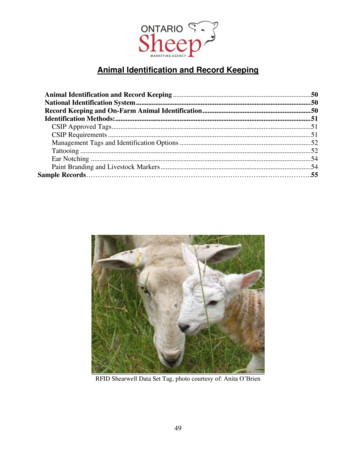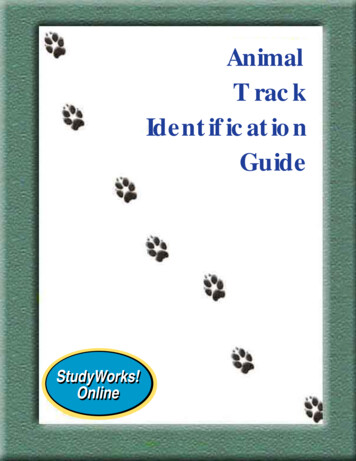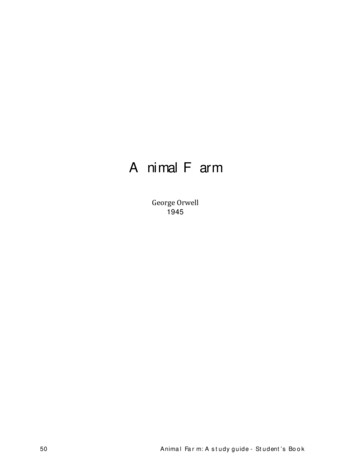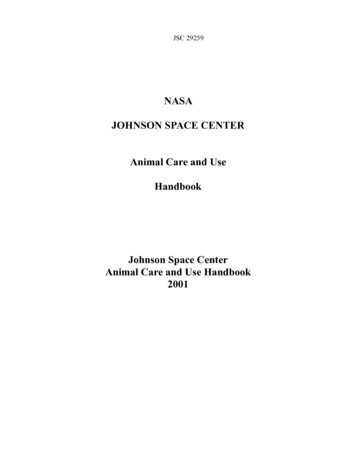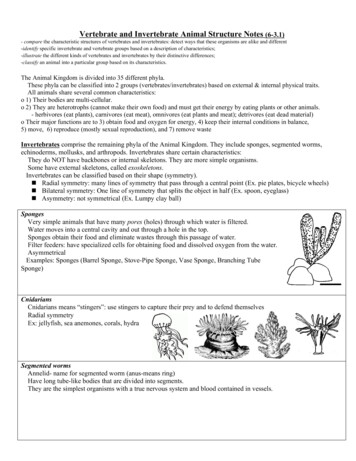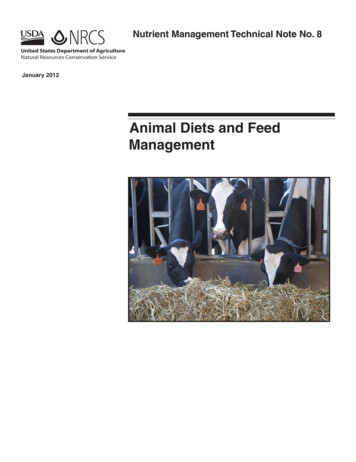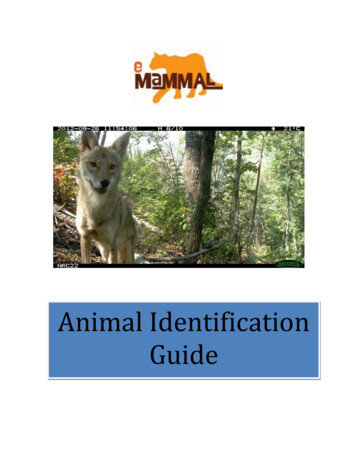
Transcription
Animal IdentificationGuide
Distinctive Species:White Tailed DeerWhite tail deer have a tan to reddish-brown coat in the summer and slightly duller colorvariations during the winter. Males possess antlers during the summer months which areshed during the winter. As the name suggests, white tailed deer have brown tails with awhite underside, and often white underbellies. Fawns have reddish coats, and while theyare still young have white spots along their backs and sides. They are common in forests;especially ones that have open fields or brush lands, as they feed predominantly on grassesand other vegetation. White-tailed deer are found almost anywhere in the United States.Northern RaccoonNorthern raccoons are common almost anywhere in the United States. Their most obviousfeatures are their ringed tails, white faces, and mask-like patches around the eyes.Northern raccoons have coarse looking fur that usually ranges from black to gray, althoughbrown, red and albino raccoons have also been documented. They are well known as beingscavengers, and therefore can live in almost any environment that has water and some sortof shelter. They are extremely curious animals and close-up pictures of raccoon faces arecommon on camera-traps.
Virginia OpossumVirginia opossums, a predominantly nocturnal scavenging species native to the southernUnited States, sport a white head and predominant long, furless pink tail. These opossumshave scruffy looking gray body fur, as well as small, leathery ears and a pointed, pink snout.Virginia opossums are often found in forests and woodlands, but due to their scavengingnature are also found in urban areas as well. These mammals are the only marsupials foundin North America.American Black BearBlack bears are one of the smaller species of bear and live in the northern parts of NorthAmerica. However, their population stretches down along the Appalachian mountain chain,where they live in woodlands and swamps. As their name suggest, black bears are mostcommonly dark brown or black, although variations of brown or tan are not unknown.Most black bears have lighter colored muzzles and/or white patches on their chest.American black bears are omnivores, although predominantly eat plant matter andscavenge food. Bears are very curious of camera-traps and bear-induced damage tocameras is possible.
Eastern CottontailThe eastern cottontail rabbit is the most common cottontail rabbit in the United States.Their range covers the East Coast to the Midwest, and they live in a variety of habitatsstretching from mountain woodlands to coastal meadows, where they eat a variety ofgrasses and other vegetation. They can be distinguished from other rabbits by their lack ofblack fringe or markings on their ears and faces that other species of rabbits possess.Eastern cottontails, however, may have white patches or markings on their face and aroundtheir eyes. They have dull brown or grayish fur and white underbellies. They are mostcommonly seen at night, and can run up to speeds of eighteen miles and hour.Wild TurkeyWild turkeys, well known for their distinctive gobbling sound and flamboyant appearance,are native to the Mid- and Eastern United States. They are overall a dark-feathered birdwith white and dark brown wings and long, featherless legs. The wild turkey has a veryslim, featherless head and neck, which can differ in color from red to blue. Turkeys usuallytravel as part of a flock, feeding on nuts and small invertebrates on the forest floor. Theymost commonly live in mature forests. At night, wild turkeys fly up into the trees as a flockto roost among the branches.
WoodchuckWoodchucks, often called groundhogs, are a medium sized rodents closely related tomarmots. They are common in the Eastern United States, and range from forest edges toopen farmland where they feed on nuts, insects, and wild grasses. Woodchucks are largeand chunky with rather stubby tails and a coarse coat that ranges from gray to variations ofbrown. They have black feet and darker heads, which are overall broad and flat.Woodchucks are excellent diggers; they dig both simple and complex burrow systems, thedepth and length depending on the type of soil. Most burrows are 25 to 30 feet long andfrom two to five feet deep, with at least two entrances.Eastern ChipmunkEastern chipmunks are one of 22 different species of chipmunks, which are members of thesquirrel family. Eastern chipmunks are the only species of chipmunk in the Eastern UnitedStates, which makes identification easier. Their distinctive striped brown and white coat, aswell as their long, dark tail distinguishes them. Eastern chipmunks are usually a pale brownto chestnut color, with darker fur around their stripes and a russet rump. They are mostcommon in forests and woodlands, but also thrive in human-dominated ecosystems. Theyeat roots, seeds, insects, and wild grasses.
Weasel-Like Animals:Short-tailed WeaselThis weasel has a dark tail top and typically white feet. They are smaller than thelong-tailed weasel and have a relatively shorter tail dark-tipped tail but like theirlong-tailed counterparts, they are brown in the summer and white in the winter.These weasels are found typically in northern states and Canada but can make it asfar south as Maryland. They are nocturnal hunters preying on small mammals.Short-tailed weasels are commonly known as Ermines.Long-tailed WeaselThis is the most widely distributed weasel in the United States; their range extendsover most of the country. This weasel is larger than the short-tailed weasel with arelatively longer, dark-tipped tail often having white on their front and/or back legs.Like the short-tailed weasel, in the northern part of their range they will molt towhite in the winter. Long-tailed weasels primarily feed on rodents although theyare opportunistic predators and will take birds, cottontails, and reptiles if available.Their long slender shape enables them to enter the burrow of their prey.
American MinkAmerican minks are dark brown, semi-aquatic weasels that are common near waterways inNorth America, excluding the Southwest and Western portions of the United States. Amainly nocturnal species, American minks are sleek, thick-furred mammals with a long tailand neck. They have webbed toes for swimming on their short, stocky hind legs. Americanminks usually have small patches of white on their chin or throat, but are otherwise a soliddark color. They eat a wide range of foods, including but not limited to fish, eggs,invertebrate, and sea birds. Although similar to otters, minks can be distinguished by theirlong, non-tapering tails (otters have shorter, flatter ones).Northern River OtterNorthern river otters are large, semi-aquatic mammals that possess a thick brown coat withsilvery to white chins and throats. Unlike the American mink and sea otter, the river otterhas a long, thick tail which tapers into a point at the tip. They are larger than both as well,and have webbed toes on all four feet. They are most often seen at dusk or dawn aroundmarshy or unpolluted marine habitats, and their diet consists mainly of marineinvertebrates and fish, as well as frogs and crayfish. River otters are excellent swimmers,but they can run on land as well; they are well known as being a generally a playful species.
Dog-Like Animals:Red FoxRed foxes are medium-sized predators that feed on rodents, rabbits, birds and othersmall game. Although they are called “red” foxes, their fur can be red, silver, gray orblack. Red foxes have a distinctive white tail tip, black legs and black ear tips whichdistinguish them from gray foxes. Red foxes are found throughout Canada and mostof the United States where they prefer landscapes with a mixture of open fields andbrushy or forested areas. These foxes are thought to have declined in the east due tocoyote expansion.Gray FoxThe gray fox is a medium-sized omnivore, eating fruits as well as small mammals,birds and amphibians. Their fur is gray and they have a distinctive black stripedown their back that ends in a black-tipped tail. They lack the black “stocking” feetof the red fox and their snout is shorter and more cat-like in appearance than thered fox. Gray foxes readily climb trees, hopping from branch to branch whenhunting or seeking protection. Gray foxes are found throughout the United Statesand into Mexico. They prefer hardwood forests and brushy riparian habitats.
CoyoteThe coyote is a large, pack-living carnivore common throughout Canada, the UnitedStates and Mexico. Coyotes have a very varied diet consisting of fruits and small tomedium-sized prey. Their coloration is varied, though typically gray, black orreddish-brown with pale throat and belly. They can be distinguished from the foxesdue to their larger size, longer limbs, longer ears and longer snouts. Coyotes haveexpanded their range following the persecution of gray wolves in the United Statesand are common in all types of natural habitats.
SquirrelsEastern Gray SquirrelThe eastern gray squirrel is the most commonly seen mammal in the eastern UnitedStates. It is a hoarder that gathers food such as nuts and berries and hides them inmany small caches to go back and eat later. The gray squirrel has a mostly gray backthat may have a hint of red-brown, a white belly, and a large bushy tail. They areusually half the size of fox squirrels with a less colorful coat and larger than theflying squirrel with a bushier tail and lack of a wing membrane. The gray squirrelusually builds leaf nests in hardwood trees and is common in forested and urbanareas.Eastern Fox SquirrelThe eastern fox squirrel is the largest species of squirrel native to North America.They eat a variety of foods including tree seeds, fruits, grains, insects, birds’ eggs,lizards, and small snakes. They come in a variety of colors from black to brown torusty-gray. They have a more bushy tail than eastern gray squirrels and are usuallytwice their size. They are also much larger than the southern flying squirrel with abushier tail and lack of a wing membrane. They often have distinguishing black orwhite markings on their faces. Fox squirrels prefer habitats with an openunderstory.
Southern Flying SquirrelThe southern flying squirrel is the only squirrel listed in this guide that is active atnight. It does not actually fly, but rather glides from tree to tree, sometimes as far as90 meters away. The squirrel uses a parachute-like membrane connected to itswrists and ankles to spread out and glide. Their diet usually includes fungi, nuts,fruits, and bird eggs. The flying squirrel is smaller than the gray and fox squirrel,has a less bush tail, and a wing membrane with a blackish edge. The flying squirrelis commonly found in hardwood forests in eastern North America.
Skunks:Striped SkunkThe striped skunk is the larger of the two species of skunk found in theSoutheastern United States. It is usually marked with a pair of stripes running downits back and join together to form a V at the back of the neck. They are larger andhave stripes rather than spots going down their back that distinguishes them fromthe spotted skunk. They are nocturnal hunters that eat insects and smallvertebrates in a variety of habitats. They will typically raise their tail and stomptheir front feet before spraying a liquid with a very strong smell.Eastern Spotted SkunkThe spotted skunk is the smaller of the two species of skunk found in SoutheasternUnited States. They have thin white spots and a white tip to a mostly black tail thatdistinguishes them from the striped skunk. This skunk is rare in the Southeast,choosing to live in habitats with extensive cover. They hunt insects, mice and othersmall animals. The spotted skunk may perform a typical handstand before sprayinga liquid with a very strong smell.
Cat-Like Animals:BobcatBobcats typically have a yellowish to reddish brown coat marked with dark streaksand spots and a very short tail. Their ears are short and have black tufts of fursticking out from the tips. They primarily hunt rabbits and other small animals atnight and are found throughout almost all of North America. Adult bobcats areabout two times as large as a domestic cat. They are also distinguished fromhousecats by their consistent coat coloration and short tail.Domestic CatDomestic cats are an invasive species introduced to the wild by pet owners. Theyfeed on a variety of native wildlife including birds and small mammals. They areabout half the size of bobcats, have along tail and a variety of coat colorations.
Eastern Fox Squirrel The eastern fox squirrel is the largest species of squirrel native to North America. They eat a variety of foods including tree seeds, fruits, grains, insects, birds’ eggs, lizards, and small snakes. They come
